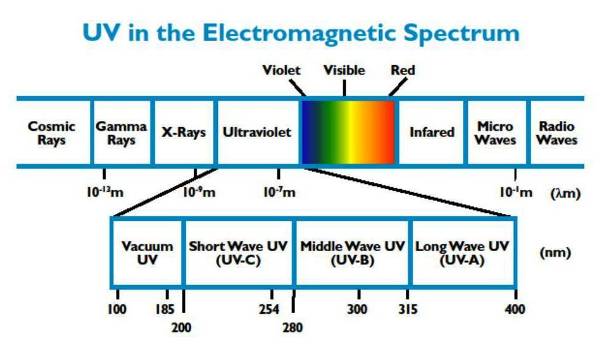
Light emitting diodes (LEDs) are available in a wide range of wavelengths. The original LEDs emitted in the infrared, followed by LEDs that emit in the visible wavelengths (red and green), followed by blue LEDs which, when coupled with phosphors, emit white light. Historically, the most difficult LEDs to produce were those that emit in the ultraviolet. Today however, the ultraviolet light-emitting diode (UV LED) industry is experiencing tremendous growth.
The three ranges of UV light are UV-A, UV-B, and UV-C (Figure 1). UV-A is also known as near-UV or black light and has a wavelength in the range of from 315 nm to 400 nm. UV-B is also known as medium wave light and has a wavelength in the range from 280 nm to 315 nm. UV-C is also known as short wave UV light and has a wavelength in the range of from 200 nm to 280 nm. It is the UV-C that we will be discussing here.
What is unique about UV-C radiation is that it is especially effective at disinfection. In particular, the wavelength of 264 nm is incredibly impressive at killing germs, viruses and bacteria. Fortunately, UV-C radiation can pass through air without creating ozone, so UV-C lamps can be used in air to disinfect surfaces. Some people may be concerned that using a UV-C LED lamp will create ozone (a health and environmental hazard). However, only the vacuum-LED wavelengths can create ozone (<200 nm). UV-A, UV-B and UV-C wavelengths do not transform oxygen (in air) into ozone.
The market for UV-C disinfection is growing, driven partly by recent outbreaks and fear of viruses and bacteria such as SARS, MERS, MRSA, Ebola, norovirus, C-DIFF and now COVID-19. UV LEDs can play a useful role in preventing infectious disease. They may be used to make water potable, replace chlorine as a water disinfectant in swimming pools, kill germs in clothes washers and dishwashers, kill airborne germs in air purifiers and HVAC systems, and disinfect surfaces in hospitals, kitchens, schools, offices and nursing homes. UV-C LED products are already available for high-end applications like industrial water purification, but there is a strong push to reduce the cost of the LED chips in order to address the very large consumer market for disinfection.

A challenge in packaging UV-C LEDs is the window mounted atop the LED package. Nearly all organic materials absorb UV-C radiation, so the same “glob top” silicones used atop visible light, UV-A and UV-B LEDs are inappropriate for UV-C LEDs. The only two practical window materials for UV-C LEDs are high purity silica glass (fused silica SiO2) and sapphire (Al2O3). Another unique challenge with UV-C LEDs is their low efficiency; conventional UV-C LEDs have an efficiency ≤ 15%, so it is very important to include an anti-reflective (AR) coating on both faces of the window in order to maximize photon emission from the package.
Materion offers a wide range of windows for UV-C applications, tailored to a customer’s requirements. The window material can be sapphire or fused silica. An anti-reflective coating may be applied to one or both faces of the window. Windows are available as either hermetic or non-hermetic. For hermetic windows, the perimeter of the window can be thin film-metalized to enable tack welding of a solder preform, similar to that of a ceramic Combo-Lid cover (Column to right). Materion can also solder the window into a Kovar™ or Invar™ frame, similar to that of Visi-Lid covers. Non-hermetic windows can be provided with a B-staged epoxy preform chemically tacked to the perimeter. Curing of the epoxy provides a seal that will resist the ingress of liquids such as water.
Materion’s UV-C windows leverage our many years of experience in manufacturing high performance microelectronics packaging, including our Visi-Lids™, ceramic Combo-Lids™ and Epo-Lid™ covers. We are the world’s leading supplier of hermetic lids for the semiconductor, medical, MEMS or optical market, and can provide anything from prototype quantities up to high volume production. For more information, please contact Simon Osborne, Global Marketing Manager at simon.osborne@materion.com. For further technical information regarding Ultra Violet Coating technology, please see our technical paper Ultra Violet Coating Technology previously featured in the Coating Materials News.
Note: Materion does not manufacture UV Packaging or LEDs, including UV-C LEDs. This article is intended for informational purposes only.